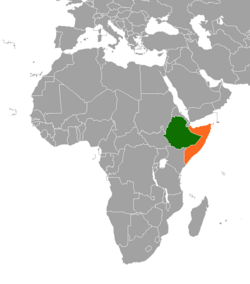Ethiopia–Somalia relations
This article needs to be updated. (November 2021) |
 | |
Ethiopia |
Somalia |
|---|---|
Ethiopia–Somalia relations (
History
Antiquity and Early modern period
Relations between the peoples of Somalia and Ethiopia stretch back to antiquity, to a common origin. The Ethiopian region is one of the proposed homelands of the
The earliest form of
The first mention of the ethnonym "Somali" in Ethiopian records dates back to the reign of Emperor Yeshaq I who had one of his court officials compose a hymn celebrating a military victory over the Sultan of Ifat's eponymous troops.[5]
In response to centuries of mistreatment of Muslims by the
Modern period
In 1948, under pressure from their
Tensions over the Ogaden region later flared up again immediately after Somalia had acquired its independence in 1960. On 16 June 1963, Somali guerrillas started an
In July 1977, the Ogaden War broke out after the Siad Barre government in Somalia sought to incorporate the Ogaden into a Pan-Somali Greater Somalia. In the first week of the conflict, Somali armed forces took southern and central Ogaden and for most of the war, the Somali army scored continuous victories on the Ethiopian army and followed them as far as Sidamo. By September 1977, Somalia controlled 90 percent of the Ogaden and captured strategic cities such as Jijiga and put heavy pressure on Dire Dawa, threatening the train route from the latter city to Djibouti. After the siege of Harar, a Soviet-led coalition of 20,000 Cuban forces and several thousand Russian experts came to the aid of Ethiopia's communist Derg regime. By 1978, the Somali troops were ultimately pushed out of the Ogaden. This shift in support by the Soviet Union motivated the Barre government to seek allies elsewhere, eventually enabling it to build the largest army on the continent.[14]

With changes in leadership in the early 1990s brought on by the outbreak of the
In October 2011, a coordinated multinational operation began against Al-Shabaab in southern Somalia, with the Ethiopian military eventually joining the mission the following month.[18] According to Ramtane Lamamra, the AU Commissioner for Peace and Security, the additional Ethiopian and AU troop reinforcements are expected to help the Somali authorities gradually expand their territorial control.[19]
The Federal Government of Somalia was later established on August 20, 2012,[20] representing the first permanent central government in the country since the start of the civil war.[20] The following month, Hassan Sheikh Mohamud was elected as the new Somali government's first President, with the Ethiopian authorities welcoming his selection and newly appointed Prime Minister of Ethiopia Hailemariam Desalegn attending Mohamud's inauguration ceremony.[21]
On 1 January 2024, Ethiopia and Somaliland signed a memorandum of understanding giving Ethiopia access to the Red Sea via the port of Berbera in return for recognizing Somaliland. The announcement infuriated Somalia, which recalled its ambassador to Ethiopia and immediately declared blocking the accord a national priority. On 6 January, President Mohamud signed a parliamentary bill declaring the deal “null and void”, though this step was mostly rhetorical. [22][23]
References
- ISBN 0226475611.
- ^ Pankhurst, Borderlands, p. 40.
- ^ J. Spencer Trimingham, Islam in Ethiopia (Oxford: Geoffrey Cumberlege for the University Press, 1952), p. 71.
- ^ Pankhurst, Borderlands, p. 79.
- ^ I.M. Lewis, A modern history of the Somali: nation and state in the Horn of Africa, 4, illustrated edition, (James Currey: 2002), p.25.
- ^ Saheed A. Adejumobi, The History of Ethiopia, (Greenwood Press: 2006), p.178
- ^ Encyclopædia Britannica, inc, Encyclopædia Britannica, Volume 1, (Encyclopædia Britannica: 2005), p.163
- ^ John L. Esposito, editor, The Oxford History of Islam, (Oxford University Press: 2000), p. 501
- ^ David D. Laitin and Said S. Samatar, Somalia: Nation in Search of a State (Boulder: Westview Press, 1987).
- ^ Cambridge illustrated atlas, warfare: Renaissance to revolution, 1492-1792 By Jeremy Black pg 9
- ^ Federal Research Division, Somalia: A Country Study, (Kessinger Publishing, LLC: 2004), p. 38
- ^ Laitin, p. 73
- ^ a b Zolberg, Aristide R., et al., Escape from Violence: Conflict and the Refugee Crisis in the Developing World, (Oxford University Press: 1992), p. 106
- ISBN 0-87436-892-8.
- ^ "Ethiopian Invasion of Somalia". Globalpolicy.org. 14 August 2007. Retrieved 27 June 2010.
- ^ United Nations High Commissioner for Refugees (1 May 2009). "USCIRF Annual Report 2009 – The Commission's Watch List: Somalia". Unhcr.org. Archived from the original on 10 May 2011. Retrieved 27 June 2010.
- ^ Central Intelligence Agency (2011). "Somalia". The World Factbook. Langley, Virginia: Central Intelligence Agency. Retrieved 5 October 2011.
- ^ "Ethiopia Agrees to Back Somalia Military Operations, IGAD Says". Businessweek. 1 December 2011. Archived from the original on 29 July 2012. Retrieved 22 August 2012.
- ^ "AU official says Ethiopian troops may pull out of Somalia next month". 17 July 2012. Archived from the original on October 1, 2013. Retrieved 23 August 2012.
- ^ a b "Somalia: UN Envoy Says Inauguration of New Parliament in Somalia 'Historic Moment'". Forum on China-Africa Cooperation. 21 August 2012. Retrieved 24 August 2012.
- ^ Mohamed, Mahmoud (17 September 2012). "Presidential inauguration ushers in new era for Somalia". Sabahi. Retrieved 30 September 2012.
- ^ Kheyr (2024-01-01). "Somaliland and Ethiopia: Recognition for Sea Access". Somali News in English | The Somali Digest. Retrieved 2024-01-02.
- ^ Endeshaw, Dawit; Sheikh, Abdi (2024-01-01). "Ethiopia signs pact to use Somaliland's Red Sea port". Reuters. Retrieved 2024-01-02.


